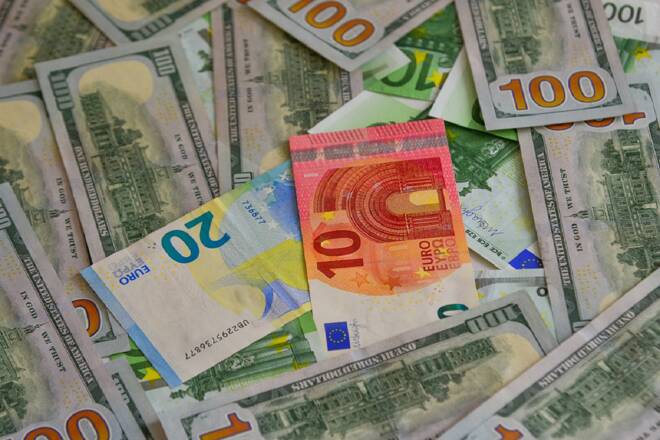Advertisement
Advertisement
EUR/USD Jumps on Improving German Investor Morale
By:
German investor sentiment rose again on hopes that inflation will fall soon despite an overall negative view on the outlook for the German economy.
The Euro is firming following the release of mixed economic news. However, the results of the German ZEW Economic Sentiment, ZEW Economic Sentiment, Trade Balance and Flash Employment Change reports were not strong enough to change the economic outlook for the Euro Zone nor European Central Bank policy.
Despite the slight upside bias following the reports, the single currency remains just under its intraday high at 1.0418.
At 10:19 GMT, the EUR/USD is trading 1.0405, up 0.0080 or +0.77%. On Monday, the Invesco CurrencyShares Euro Trust ETF (FXE) settled at $95.30, down $0.27 or -0.285.
Mixed Economic Data
The Euro Zone swung to a large trade deficit in September from a small surplus a year earlier due to a surge in the costs of imported energy in the wake of Russia’s invasion of Ukraine, but the deficit was smaller than expected, data showed on Tuesday.
Euro Zone gross domestic product grew by 0.2% quarter-on-quarter in the July-September period for a 2.1% year-on-year increase, Eurostat confirmed on Tuesday, while employment in the single currency also rose.
Finally, German investor sentiment rose again in November on hopes that inflation rates will fall soon despite an overall negative view on the outlook for the German economy.
The ZEW economic research institute said on Tuesday its economic sentiment index rose in November, to -36.7, from -59.2 in October.
ECB Official Says Central Bank Would Continue to Lift Rates
In other news, ECB Vice President Luis de Guindos said on Monday the European Central Bank (ECB) would continue to raise interest rates, proceeding “with prudence”, to get inflation back to target, even if this process takes an “extended” period.
Short-Term Outlook
In the U.S., financial futures traders are pricing in an 89% chance of a 50 basis point rate hike by the Fed in December. The ECB is likely to raise rates by 75 basis points. This divergence is making the Euro a more attractive asset.
The current rally from .9730 began on November 3, one day before the release of the U.S. Non-Farm Payrolls report that showed an uptick in the U.S. Unemployment Rate. The common currency has been accelerating since last Thursday when the U.S. government released cooler-than-expected consumer inflation data that drove U.S. Treasury yields sharply lower along with the U.S. Dollar, fueling the current rally in the EUR/USD.
Later today at 13:30 GMT, traders will get the opportunity to react to the latest data on U.S. producer prices (PPI). Another report showing a cool down in U.S. inflation could launch a similar rally.
For a look at all of today’s economic events, check out our economic calendar.
About the Author
James Hyerczykauthor
James Hyerczyk is a U.S. based seasoned technical analyst and educator with over 40 years of experience in market analysis and trading, specializing in chart patterns and price movement. He is the author of two books on technical analysis and has a background in both futures and stock markets.
Did you find this article useful?
Latest news and analysis
Advertisement
